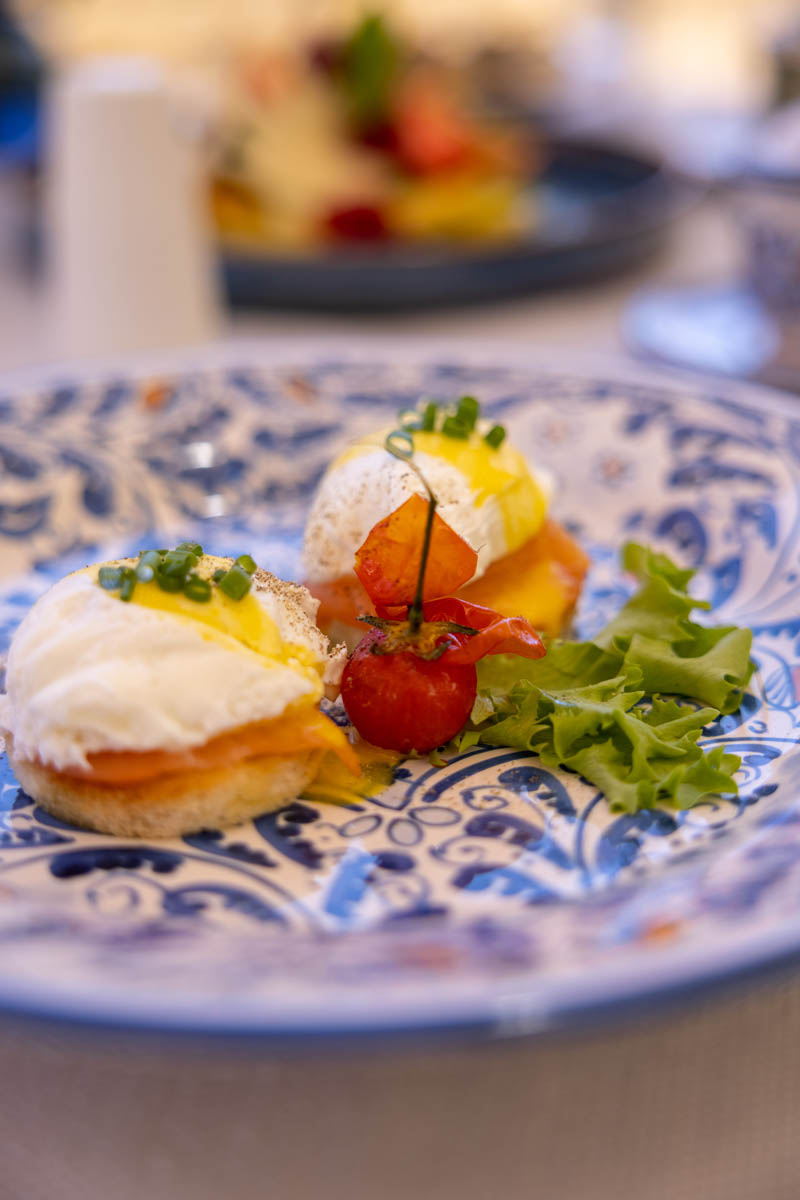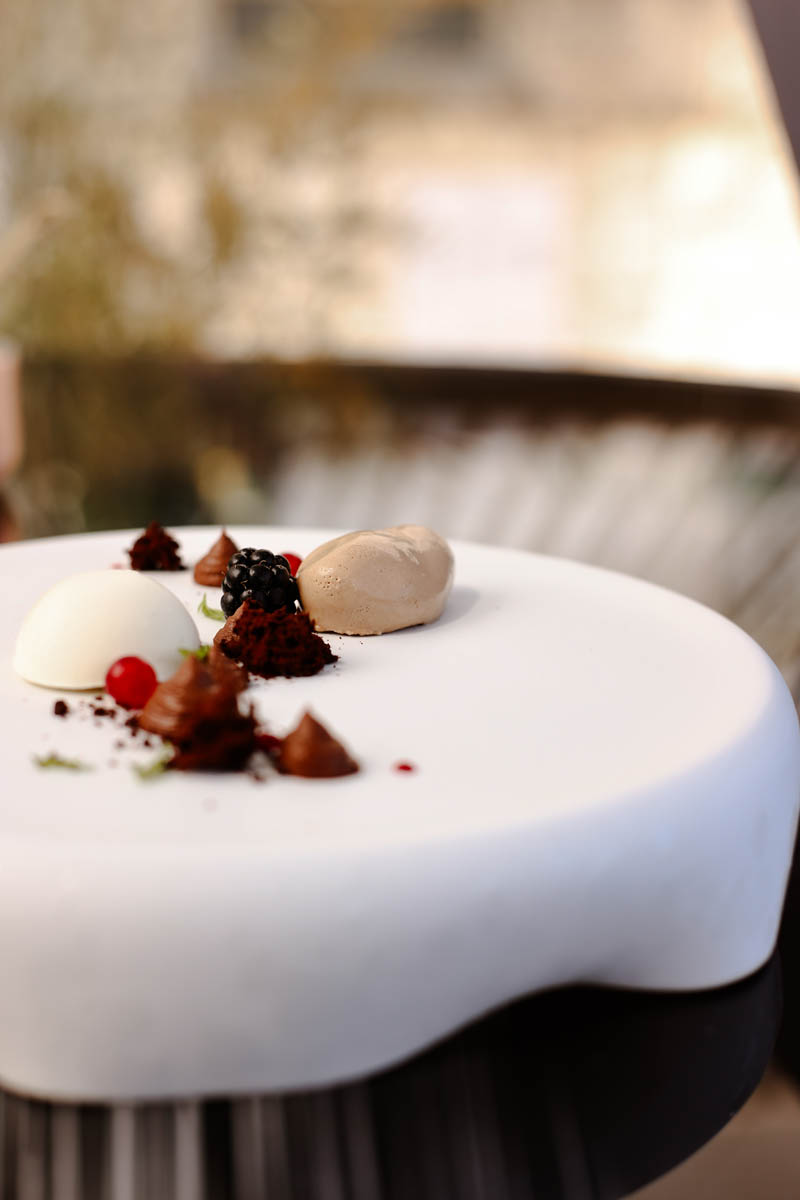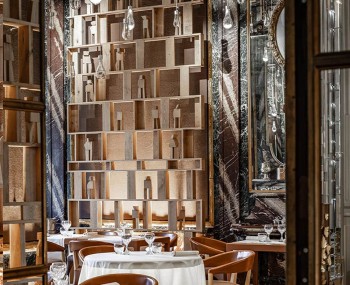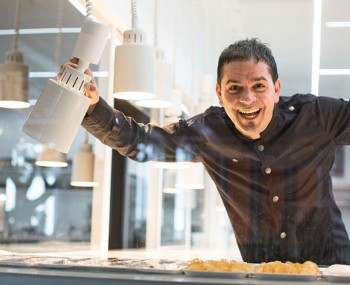In Taormina a luxury upgrade thanks to Blum restaurant, where the offering moves away from the strict concept of territory to embrace contemporary cuisine.
The story
When one thinks of Sicily and elite tourism, Taormina and its peculiarities cannot be ignored. It is a perfect synthesis of glamour, culture, and beauty, making it a perennial favorite destination for actors, CEOs, entertainment personalities, and world-renowned intellectuals. They are drawn to the unique lifestyle, of which VRetreats Collection, a luxury hospitality brand that redesigns the concept of luxury, proves to be a perfect interpreter and narrative voice.


The Mazzarò Sea Palace originated as a private residence before transforming into a hotel in the 1970s. It became part of the VRetreats collection and later joined Leading Hotel of the World, an association boasting 400 luxury establishments in 80 countries. Overlooking the Mazzarò bay, situated in one of the most enchanting and less chaotic stretches of the Sicilian coast, it features 70 splendid rooms, each equipped with a sea-view terrace.


Its proximity to the funicular allows easy access to Taormina's historic center—a maze of medieval streets filled with local eateries offering typical gastronomic specialties, exclusive boutiques, artisan shops, and numerous attractions that have become symbols of the city. These include the Greek Theatre, providing a splendid view of Mount Etna and the entire coast, and Isola Bella, a tidal island once the residence of the wealthy English noblewoman Florence Trevelyan and now part of a well-preserved nature reserve.


For those seeking moments of pure relaxation and well-being in a unique and private atmosphere, the hotel offers various services facilitated by a well-trained, professional staff ready to meet any need. These services include a free private beach, accessible via sea transfer, a pool, solarium, the Hyd’Or wellness center with exclusive treatments using raw materials from the island such as oranges, and a 24/7 fitness area for those wishing to stay fit even during vacations. The interiors of both rooms and common spaces are elegantly furnished with a contemporary and refined style, especially in the numerous precious objects present. They evoke Mediterranean colors, creating a comfortable and relaxing environment.

The outdoor terraces, characteristic of the establishment, mirror the motifs used inside and serve as a natural extension of the hotel—true outdoor lounges that seamlessly integrate with the beauty of the surrounding landscape. An example of this is the Almarè bar, where a rich and varied breakfast is served in the morning, ranging from sweet to savory, including products for those with dietary intolerances. All sourced locally from selected small producers, ensuring absolute quality and traceability in the supply chain.



As the hours go by, we reach the aperitivo moment, featuring wines from Mount Etna or excellently crafted cocktails prepared by bartender Francesco Truglio. These can be accompanied by mini arancini with spinach or ragù and almonds, toasted and salted. Marilena Calabrò, the excellent hostess and General Manager of Mazzarò Sea Palace, affirms, "We love to tell the Sicilian story in both dishes and drinks, seeking and selecting the best local products at zero miles."


However, the choice to use local raw materials and support small producers is just one aspect that demonstrates a great commitment to sustainability. This commitment is achieved through the elimination of single-use plastic, avoiding waste, especially of water, thanks to specific mixers that measure its usage. The concept extends to providing staff with recycled and degradable footwear, to be returned to the manufacturing company at the end of use for proper disposal. Since 2022, the hotel exclusively relies on electricity from renewable sources.

Marilena further adds, "Moreover, 90% of our staff is Sicilian, and with very little turnover, they manage to portray the hotel as if it were their own home." All these efforts are encapsulated in the GSTC certification (Global Sustainable Tourism Council), which evaluates effective sustainability planning, social and economic benefits for the local community, cultural heritage enhancement, and reduction of negative environmental impacts.

The restaurant
Short supply chain, zero-mile ingredients, artisanal productions, and local traditions are also the cornerstone elements of Armònia, the main restaurant of the hotel, offering an authentic, simple, and instantly gratifying seafood cuisine. However, there was a felt need for an upgrade, to offer something more sophisticated and less tied to local traditions and island culture. This led to the creation of Blum restaurant, the Italian pronunciation of the English noun "bloom," meaning "flowering."


A platform that accommodates 12 covers and seems to be placed on the water, thanks to walls and floors made of glass. On these surfaces, designer tables, also made of glass and rope, are arranged along with armchairs using the same materials. The mise en place is refined yet minimal, never distracting attention from the sea, which serves as the backdrop to an experience immediately free from classic schemes and stereotypes.

"In my mind, the project began four years ago, but we managed to open only this year, in early June. We wanted to create something that stood out in every way, to suggest a new perspective on the concept of fine dining in Taormina," says Riccardo Fazio, the executive chef of the hotel. Sicilian, born in 1992, he has a background in hotel studies and experiences abroad, particularly in London, working in the kitchens of Harry's Bar and Anima restaurant with chef Francesco Mazzei in the heart of Mayfair. Returning to Italy, he gathered prestigious collaborations, including those with Chef Gaetano Trovato of the Arnolfo restaurant in Tuscany and Gaetano Procopio at the iPalici restaurant of Relais San Giuliano on the outskirts of Catania. These collaborations allowed him to refine his technique and solidify his culinary philosophy, eventually overseeing the entire culinary offering of Mazzarò Sea Palace because, as he confesses, "I love the dynamism found in hotels."

Indeed, the offering deviates from a strict local concept to embracing contemporary cuisine, open to new ideas and inspirations without specific geographical constraints. However, the references to Sicily are not lacking, both in the clear and decisive flavors, often skillfully balanced with acidic and citrusy notes, and in the choice of less-known ingredients paired in unusual but still authentic ways. Examples include the bottarga (mullet roe) or Tuma Persa, a rare cheese found only in the region: "I would like my guests to immediately understand what they are about to eat, but at the same time, by tasting the dishes, be surprised," explains the chef.

It's as if he communicates his cuisine using a new language, less understandable, but his "accent" betrays its origins: "Local for me is Italy. I don't follow guidelines or trends, but I try to have my own idea of cooking and to be inspired by an ingredient that evokes emotions, regardless of its origin, and then seek its maximum expression, as in the case of eel, which took me three months to source, with the aim of obtaining something beautiful and tasty, often the result of countless trials and attempts," he continues. The restaurant is only open for dinner, offering two tasting menus: a 6-course menu priced at 150 euros and a vegetarian option with 5 courses at 100 euros. Guests can also opt for a wine pairing of 3 glasses for 60 euros or 5 glasses for 80 euros. While there isn't a traditional menu, a more streamlined option allows choosing 2 dishes from the tasting menus plus dessert for 90 euros, with the option to add a cheese selection for 38 euros.

The dishes
The delightful amuse-bouche immediately puts into practice the concept of a cuisine that looks beyond borders, nodding to Spain and Mexico, but without forgetting the homeland. These include the "non-standard mackerel" with ricotta cream, eggplant, confit tomato, and basil, the tartlet with tuna, watermelon, almond, and lemon zest, the duck tartare taco with vinegar dressing and Parmigiano cream, and the cuttlefish ink cracker with Cantabrian anchovies, anchovy mayonnaise, celery, and capers. The selection of homemade yeasts is noteworthy, featuring classic and tomato grissini, Parmigiano Reggiano and saffron crackers, and semi-wholemeal bread made exclusively with sourdough, accompanied by homemade butter in salted, tomato, and lemon variations.


The tasting journey begins with "langoustine, pear, and caviar," a dish with a Mediterranean soul, both in flavors and colors. Marinated langoustine with balanced salt, chips, and mayonnaise from the shells, pears, and a sauce made with white fish, caviar, and lime: fresh, savory, acidic, very elegant, and an excellent start. The "bitter ravioli, Tuma Persa, black bee honey, and bottarga" is bold, robust, and comforting at the same time. Fresh pasta is filled with curly endive, wild chicory, and arugula, accompanied by Tuma Persa fondue, homemade tuna bottarga, and Sicilian black bee honey, providing the necessary sweetness to balance the dish, paired with an intriguing gin-based drink infused with sage and lemon.

Moving on to "eel, Granny Smith cider, and potato": the fish is marinated in apple cider and Calvados, perfectly cooked on the kamado and served with apples, perhaps in excessive quantities, a tasty potato mille-feuille, and a truly well-executed eel sauce. The "pigeon, banana, and berries" dish is a tribute to Arnolfo and is the most international among the sampled dishes. The pigeon is presented in various cooking methods and textures, showcasing the chef's remarkable technical skills: the fillet is marinated, the thigh is slow-cooked, and the breast is pan-seared and lacquered with its rich and flavorful jus. Accompanying the dish are various sauces, including banana and berries, and chicken liver pâté. Additionally, a separate serving includes focaccia with pigeon ham, tomato, and mozzarella, completing one of the most intriguing courses of the tasting.

The dessert, "harmony of chocolate," features white chocolate mousse, 36% dark chocolate namelaka, 72% dark chocolate creamy, and a sponge of 100% dark cocoa, accompanied by blackberries, blueberries, and raspberries, providing freshness and acidity. The wine list is not particularly extensive, focusing on many sparkling options, both French and Italian, with good depth in vintages, including a dedicated section exclusively for Sicilian sparkling wines. The whites and reds also highlight the local terroir, although there are references from various Italian regions and, notably, from internationally acclaimed areas like Piedmont and Tuscany. The list also includes prestigious productions from France and Germany, along with a small selection of wines by the glass, completing an interesting offering, though not entirely aligned with the culinary philosophy. The service, led by Restaurant Manager Dana Muscalo, is knowledgeable, attentive to the customer, and very courteous, perfectly harmonizing with the international, romantic, and relaxing atmosphere of the place.













